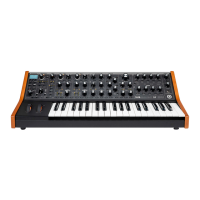25
OSCILLATORS SECTION
Oscillator 1 and oscillator 2 are the Sub 37’s primary sound
sources. They generate four basic waveforms: triangle,
sawtooth, square, and pulse. Since the WAVE knob is
continuous, you can interpolate between these shapes.
The triangle wave consists of odd-numbered harmonics only.
Its fundamental is very strong, and its overtones are very weak,
making it less harmonically complex than other waveforms. By
mixing a triangle from one oscillator with a more complex wave
from the other, you can emphasize one particular harmonic
without mucking things up with unwanted overtones.
An unfiltered sawtooth wave is much brighter, because it contains
all the natural harmonics. As the harmonics ascend in frequency,
they grow weaker in amplitude. Sawtooth waves are useful for
synthesizing bass, simulating brass instruments, and more.
Although a pulse wave contains only odd-numbered
harmonics, it offers the most flexibility because you can
change the balance of those odd-numbered harmonics by
changing its shape. Think of a pulse-wave oscillator as a switch
you can turn on and off hundreds or thousands of times per
second. In a single pulse wave, the “switch” is either on or off.
Its pulse width is the proportion of the wave that’s on, usually
expressed as a percentage. A square wave is simply a pulse
wave with 50% pulse width, meaning that in a single cycle, it is
on half the time and off half the time. If its frequency is 440Hz,
that means it goes on and off 440 times every second, and the result you hear is the pitch A above
middle C. Every pulse width has its own characteristic sound, because each has a unique harmonic
structure, making a variety of basic timbres possible.
Unlike most synths, which simply switch between basic waveforms, the Sub 37 allows you to gradually
change the oscillator’s output from one waveform to another, so it can generate something partway
between a sawtooth and a square wave, for example. We refer to such controls as continuously
variable because there are no discrete steps between settings.
In normal operation the keyboard, pitch wheel, arpeggiator, step sequencer, or external MIDI data control
oscillator pitch. You can also apply MOD 1, and MOD 2 to modulate oscillator pitch and waveform.
OSCILLATOR CONTROLS
OCTAVE
Use this knob to control either oscillator’s pitch range. Pitch range is expressed in feet, a reference
to the age of pipe organs, when a pipe’s physical length determined its pitch. The Sub 37’s OCTAVE
knobs cover four pitch ranges corresponding to four octaves. The lowest setting is 16’, and the highest
setting is 2’.
WAVE
Use this knob to vary either oscillator’s waveform from triangle to sawtooth to square to narrow
pulse wave. Turning the WAVE knob clockwise from the triangle to sawtooth position increases the
oscillator’s harmonic content. Continuing to turn it to the square-wave position weakens and then
eliminates even-numbered harmonics while strengthening odd-numbered harmonics. Turning it from
the square to narrow-pulse position changes its harmonic content further by weakening the overtones
relative to the fundamental frequency. This parameter can be modulated via MOD 1 or MOD 2 to create
interesting harmonic motion.

